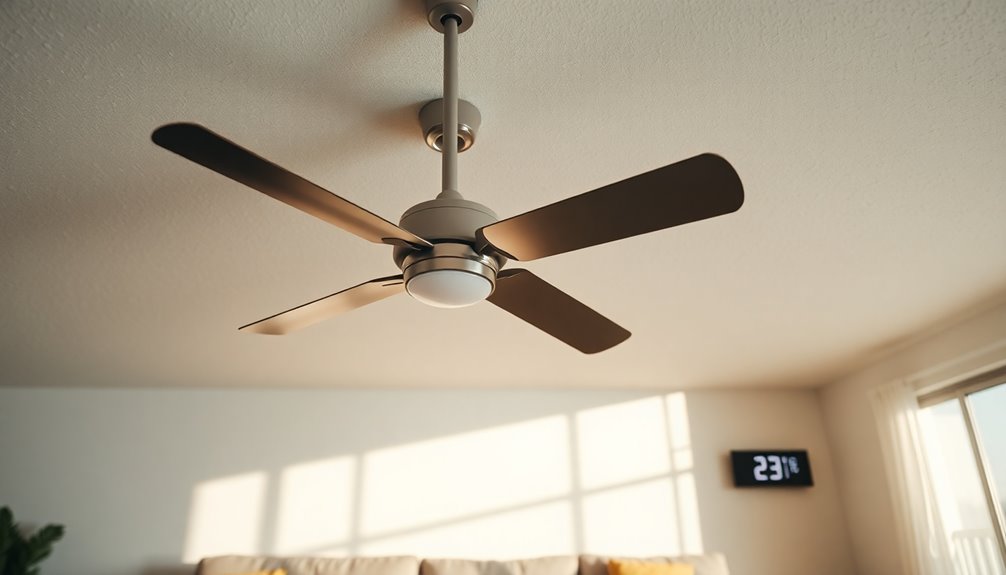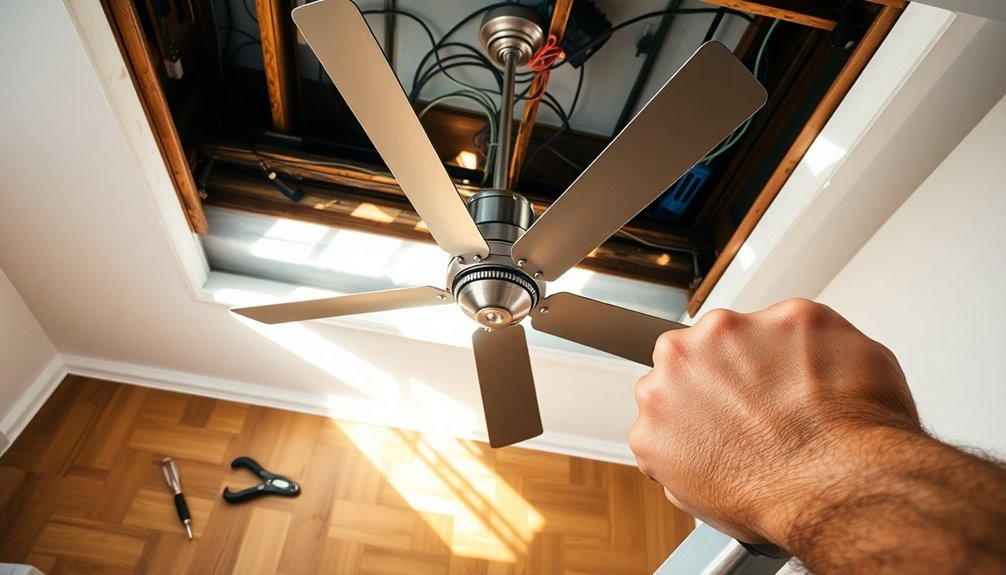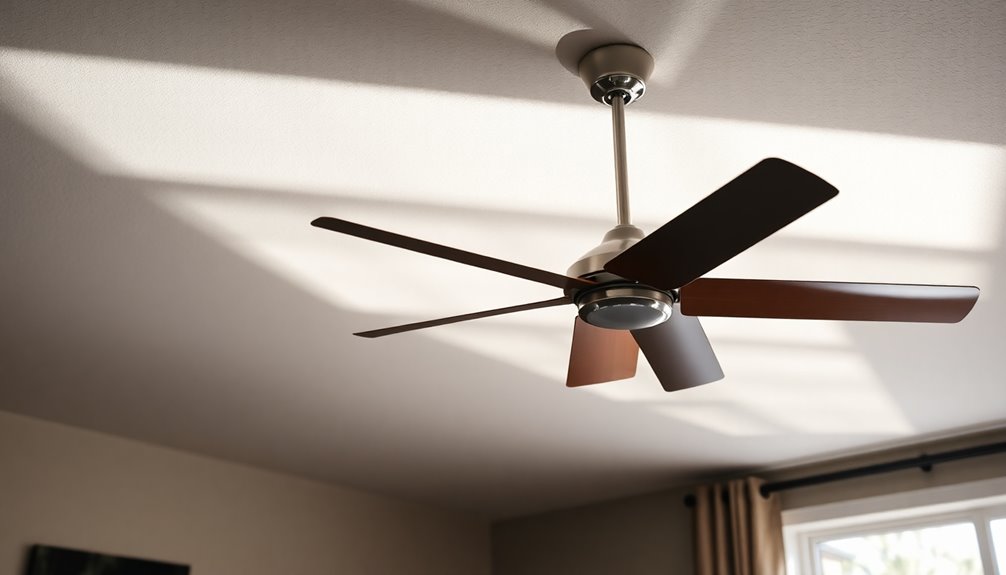If your ceiling fan isn't blowing air, check a few common issues. First, make certain it's set to rotate counterclockwise for cooling. If the blades are small or the pitch is shallow, they might not push enough air. An unlevel base can also hinder airflow, so verify it's properly installed. Additionally, inspect electrical connections; loose wiring or a blown fuse could interrupt power. Finally, don't forget to clean the blades regularly to maintain efficiency. Understanding these factors can help you troubleshoot, and you'll discover more tips to get your fan working effectively.
Key Takeaways
- The fan blades may be too small for the room size, limiting airflow efficiency.
- A tilted or unstable base can hinder proper rotation, affecting air circulation.
- The fan may be set to clockwise rotation, which limits airflow during summer.
- Electrical issues like blown fuses or loose connections can disrupt power to the fan.
- Dirty or obstructed fan blades can reduce airflow; regular cleaning is essential.
Incorrect Fan Rotation Direction

If your ceiling fan feels like it's not blowing any air, the first thing to check is the rotation direction. Ceiling fans can spin in two ways: counterclockwise or clockwise. Each direction serves a different purpose depending on the season.
During summer, you want your fan to spin counterclockwise, creating a wind chill effect that cools the room by pushing air directly downwards. If it's spinning clockwise, you're likely experiencing incorrect fan rotation direction, which can lead to airflow issues and make it feel like the fan isn't working at all.
To correct this, locate the reverse switch on the motor housing. Make sure the fan is turned off before you adjust it to avoid accidents. Once you've set the fan to spin counterclockwise, you should notice a significant improvement in airflow.
On the other hand, in winter, a clockwise rotation helps circulate warm air without creating a draft. So, if your fan is spinning in the wrong direction, it's time to make that quick adjustment for ideal comfort in your home.
Always remember, the right rotation can make all the difference!
Fan Blade Size Issues

If your ceiling fan isn't blowing air effectively, the size of the blades might be the culprit.
Ideally, blades should measure between 48 and 60 inches for maximum airflow efficiency, especially in larger spaces.
You can also explore replacement blade options to guarantee your fan meets your airflow needs.
Ideal Blade Length
Choosing the right blade length for your ceiling fan is essential for maximizing airflow in your space. The ideal blade length typically ranges from 48 to 60 inches, which effectively generates adequate airflow in most room sizes.
If your fan has small blades, usually around 30 inches, it's likely not providing enough airflow for larger areas, making it less efficient for cooling.
When selecting blades, consider these points:
- Optimal Size: 48 to 60 inches is best for effective airflow.
- Larger Blades: They cover more surface area, pushing more air downwards.
- Avoid Excessive Size: Oversized blades may create wind resistance that hinders performance.
- Easy Replacement: You can replace fan blades easily by unscrewing the old ones and sliding in new ones without needing a full fan replacement.
Airflow Efficiency Factors
Airflow efficiency in ceiling fans largely hinges on the size of the blades. If your fan blades are too small, like those on a 30-inch model, you might find they struggle to generate sufficient airflow, especially in larger spaces.
Ideally, fan blades should range from 48 to 60 inches, as larger blades can greatly improve air movement efficiency. They reduce wind resistance, allowing more air to circulate throughout the room.
Another factor to take into account is the blade pitch angle. A steeper pitch can push more air downwards, enhancing airflow dynamics, while a flatter pitch may not provide the same effectiveness.
If you notice your fan isn't circulating air well, it might be time to reassess both the size and pitch of your fan blades.
Fortunately, replacing fan blades is a straightforward process. You simply unscrew the old blades and slide in new ones, which can drastically improve your ceiling fan's airflow performance.
Replacement Blade Options
When you notice your ceiling fan isn't blowing air effectively, it might be time to contemplate replacement blade options that better suit your space. Ceiling fan blades typically range from 48 to 60 inches, with larger blades providing improved air movement efficiency. Using a fan with high suction power can help ensure that you achieve optimal airflow, similar to how a strong vacuum can effectively eliminate dust and allergens. Additionally, modern fans can significantly reduce reliance on air conditioning, which means choosing the right blades can have a broader impact on your energy consumption.
If your fan has smaller blades, around 30 inches, they may not create adequate airflow, especially in larger rooms.
When considering replacement blades, keep these factors in mind:
- Guarantee compatibility with your fan model to maintain proper airflow dynamics.
- Opt for larger blades to enhance air movement and cooling efficiency.
- Be cautious of wind resistance; improperly sized blades can hinder performance.
- The replacement process is easy—just unscrew the old blades and slide in the new ones.
- Additionally, ensuring the ceiling fan is installed correctly can further maximize system longevity and performance.
Tilted or Unlevel Base

If your ceiling fan isn't blowing air effectively, a tilted or unlevel base might be the culprit.
This issue often arises from uneven surfaces during installation, and it's essential to make certain everything is level and stable.
Let's explore the causes of base tilt, some leveling techniques, and why stability is so important for your fan's performance.
Causes of Base Tilt
A tilted or unlevel base can considerably impede your ceiling fan's ability to circulate air effectively. When the base isn't level, it disrupts the proper rotation of the fan blades, which can lead to insufficient airflow or none at all.
Several factors can contribute to base tilt:
- Uneven surfaces: If the ceiling or mounting area isn't flat, it can cause the fan to lean.
- Improper installation: Incorrectly mounted brackets or loose screws can lead to instability.
- Wear and tear: Over time, the installation can shift due to vibrations or settling in the structure.
- Lack of maintenance: Failing to check the stability of the fan regularly can result in unnoticed tilt issues.
To maintain ideal fan performance, addressing base tilt is essential. Tightening the hanger bracket screws usually resolves the issue, ensuring the blades rotate properly.
After making adjustments, don't forget to reattach the canopy for stability and function. Regular checks of the installation surface will help prevent tilt issues and prolong your ceiling fan's life.
Leveling Techniques Explained
To guarantee your ceiling fan circulates air effectively, leveling the base is vital. A tilted or unlevel base can disrupt proper blade rotation, causing ineffective airflow. To achieve ideal function, you'll need to adjust the installation surface or tighten the hanger bracket screws.
Start by checking if the fan is wobbling. If it is, that's a clear sign the base isn't level. You may have to lift or reposition the fan to get it straight.
Also, keep in mind that changes in your floor or mounting surface over time can lead to tilting, so regular checks are essential.
Once you've leveled the fan, don't forget to securely reattach the canopy. This prevents any further movement that could hinder airflow.
Remember, every little bit counts when it comes to maximizing the performance of your ceiling fan. By ensuring the fan is level, you'll not only improve airflow but also enhance the overall stability and longevity of the unit.
Regular maintenance and adjustments will keep your ceiling fan operating at its best, ensuring you enjoy a comfortable environment.
Importance of Stability
Stability plays a key role in guaranteeing your ceiling fan operates efficiently. A tilted or unlevel base can greatly hinder the proper rotation of your fan blades, leading to reduced airflow and inefficiency.
If your fan's base is uneven, it's essential to address this issue. Even a slight tilt can disrupt the intended airflow dynamics, leaving you feeling unsatisfied with your fan's performance.
To maintain ideal function, consider these steps:
- Check for uneven surfaces where the fan is installed.
- Tighten the hanger bracket screws to secure the fan base.
- Verify the canopy is properly reattached after adjustments.
- Regularly inspect the fan's stability during routine maintenance.
Height and Clearance Problems

When it comes to ceiling fans, height and clearance play a crucial role in how effectively they circulate air. If your ceiling fan is installed too close to the ceiling, it can create blockage, severely limiting airflow in your room.
According to Australian Standard AS 4226 – 2008, the fan blades should be at least 2.1 meters above the floor for ideal performance. Ideally, you want your ceiling fan to be installed between 8 to 9 feet from the floor, ensuring it can move air efficiently.
If you have low ceilings, you might've a ceiling hugger fan, which is designed to fit closer to the ceiling. However, these fans usually move less air than standard models due to their compact design, leading to potential height and clearance problems.
Conversely, if your ceilings are high, consider using downrods to lower the fan, enhancing its ability to circulate air effectively. Addressing these height and clearance issues can dramatically improve your ceiling fan's airflow and comfort in your space.
Electrical Malfunctions

Height and clearance issues aren't the only factors that can cause your ceiling fan to underperform. Electrical malfunctions can also be the culprit, preventing your fan from blowing air effectively, even if the blades are spinning at high speeds.
Common issues include:
- Blown fuses that disrupt power supply
- Loose wiring connections that interfere with functionality
- A defective fan motor that fails to generate airflow
- A faulty capacitor that regulates power to the motor
It's crucial to guarantee your fan receives adequate power and that the switch below the fan stalk is operational. Additionally, ensuring your fan is within Wi-Fi range can help maintain functionality for smart ceiling fans.
If you suspect electrical malfunctions, don't ignore the signs, as these issues can lead to further complications. A malfunctioning capacitor, for example, typically requires a replacement with a similarly rated component, such as 2.25uF to 2.5uF.
For safety and proper functionality, consider hiring a professional electrician to diagnose and repair any electrical problems.
This way, you can enjoy your ceiling fan's cooling benefits without the frustration of airflow failure or safety hazards.
Maintenance and Cleaning Tips

Keeping your ceiling fan in prime condition requires regular maintenance and cleaning to guarantee it operates efficiently. Here are some essential tips to keep your fan performing at its best:
| Task | Frequency | Purpose |
|---|---|---|
| Clean fan blades | Monthly | Remove dust to improve airflow |
| Inspect screws and connections | Every 3 months | Ensure smooth operation and prevent vibrations |
| Check for obstructions | Bi-monthly | Maintain ideal airflow |
Start by wiping down the fan blades with a damp cloth to eliminate dust and debris. This simple cleaning step can greatly improve airflow. Next, regularly inspect and tighten any screws and connections to prevent vibrations that can hinder performance. Don't forget to check for any obstructions around the fan, such as light fixtures or decorations, that may block airflow.
You should also use a vacuum with a brush attachment to clear dust buildup from the motor housing and mounting bracket. Finally, consider scheduling professional maintenance every few years to ensure all components function correctly and to address any electrical issues. By following these maintenance and cleaning tips, you'll keep your ceiling fan running smoothly and effectively.
User Experiences and Solutions

Many users have discovered that resolving airflow issues with their ceiling fans often involves simple adjustments and checks. A common fix is adjusting the fan's rotation direction. For cooling in the summer, make certain the fan runs counterclockwise.
If you're still facing problems, consider that a faulty capacitor might be the culprit. Replacing it can restore your fan's performance and improve air circulation.
Here are some user-shared solutions to enhance your ceiling fan experience:
- Check for loose wiring or internal connections to make certain everything's secure.
- Regularly clean the blades to remove dust and improve airflow.
- Make sure your fan is level, as an uneven installation can affect performance.
- Test airflow effectiveness with lightweight materials, like toilet paper squares, to confirm proper direction and speed control.
Frequently Asked Questions
Why Is My Ceiling Fan Working but No Air?
If your ceiling fan's operating but isn't blowing air, you might want to check a few things.
First, confirm the blades are rotating counterclockwise for cooling.
Next, consider the blade size; if it's too small or too large, it could affect airflow.
Also, verify that the fan's properly installed and level.
Finally, inspect for any electrical issues that might prevent it from reaching the right speed.
Adjust these factors, and you should feel the breeze!
How to Make a Ceiling Fan Blow More Air?
To make your ceiling fan blow more air, start by checking the blade size; they should be between 48 to 60 inches for ideal airflow.
Adjust the blade pitch to a steeper angle for better air movement. Confirm the fan's height is at least 2.1 meters from the floor.
Regularly clean the blades to remove dust, and switch the fan direction to counterclockwise during summer for a cool breeze.
Why Is My Fan Running but No Air?
If your fan's running but not blowing air, check a few things.
Ascertain the blades are rotating counterclockwise for cooling.
Inspect the fan's installation to see if it's tilted or misaligned.
Look for any obstructions or dirt that might be blocking airflow.
Additionally, examine the wiring and electrical components for any issues.
Why Is My Standing Fan Spinning but Not Blowing Air?
If your standing fan's spinning but not blowing air, check a few things.
First, make sure the blades are clean; dust can block airflow.
Then, look at the speed settings—if it's on low, that might explain the weak air.
You should also inspect for any obstructions around the fan.
Finally, if you suspect a motor or capacitor issue, it might be time to get it serviced or replaced.
Conclusion
So, if your ceiling fan's just spinning and not blowing air, congratulations! You've mastered the art of decorative ceiling décor. But really, check the rotation, blades, and those pesky electrical issues. With a little effort, you can turn that silent spinner into a revitalizing breeze machine. Don't worry; you won't need to hire a fan whisperer—just some basic troubleshooting will do. Now, go forth and let the air flow, because who doesn't love a good wind?









